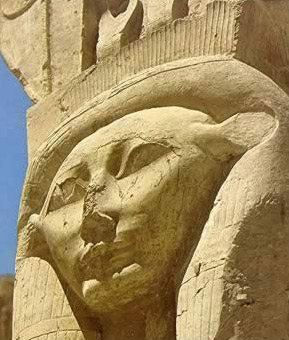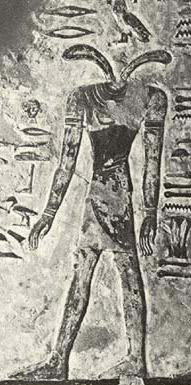Mixed Representations of Ancient Egyptian Gods
by Jimmy Dunn

The first Egyptian gods were probably thought to be manifested in animals, and so that was the form in which representations of the earliest gods were depicted. However, they soon took on a number of different forms, including human, and inanimate objects. Another form was a mixture, usually with animal heads and human bodies, though this never superseded purely animal forms of the gods, or those with completely human form. This mixed form of animal and human caused an early and passionate rejection of Egyptian religion during the classical period.
This type of iconography is characteristic of and important to the Egyptian image of the gods, and yet it has often and completely been misunderstood.
There is an astonishingly rich variety of possibilities when it comes to depicting Egyptian gods. For example the goddess Hathor was normally represented as a slim woman wearing a wig surmounted by a pair of cow horns with a sun disk between them. However, she could also be shown in pure animal form, such as in the Hathor shrines of Deir el-Bahri, with a cow's head but a human face, such as at Dendara, or with a human body and an animal head. At times, she could also be imagined as a lioness, a snake, a hippopotamus and a tree nymph. Though each of these forms are not equally old, most existed side by side. In fact, in an unusual statue group in the Louvre, she is at once depicted as a cow, a lion-headed goddess, a uraeus snake and a goddess with a sistrum on her head.

The ancient Egyptians did not imagine Hathor as a woman with a cow's head. In reality, the cow was just one possible manifestation of Hathor, and the cow's head and cow's horns were seen as attributes that alluded to her nature. Hence, in Hathor there was the maternal tenderness of the cow, but among many other characteristics, there was also the wildness of the lioness and the unpredictability of the snake. Each form makes an attempt to explain her nature.
Another example is Thoth, who may appear as an ibis, a baboon, or the moon, but also in purely human form or in a mixed form consisting of some of these elements. Hence, it is difficult to exhaust the full richness of his nature, and with deities who are combined syncretistically with other deities, the range of possibilities is vastly wider. In fact, when gods were synchronized, it was really another means of showing their attributes, as were even the names that they were given.

So essentially, the heads of ancient Egyptian gods were no more and no less than representations of their attributes. Most often, the head is that of an animal but not always, particularly in later periods. For example, at two points in the underworld book known as the Amduat, a divine being is shown with two strange protuberances in place of a head. This figure stumped Egyptologists, until, in the contemporary Litany of Re, a similar depictions was found who was named, "he who fetters". Hence, the protrusions were ropes and the attribute indicates that the function of this being was to bind the damned in the underworld.
In fact, illustrations or descriptions of appearances of gods were not seen by the Egyptians as real images of the gods, but instead portrayed essential parts of their nature and function. Henri Frankfort proposed, and many scholars agree, that the depiction of ancient Egyptian gods should be taken as ideograms, or as pictorial signs that convey meaning in a metalanguage. Whatever combination the Egyptians chose, the mixed form of their gods is nothing other than a hieroglyph, or a way of writing not the name but the nature and function of a deity. Actually, Egyptians do not hesitate to refer to hieroglyphs themselves as "gods", and even to equate individual signs in the script with particular gods.
The gods may indeed inhabit the representations made by mankind, but their true form is hidden and mysterious, as Egyptian texts continually emphasizes.Hence, none of the animals, plants and objects that are related to the manifestation of deities actually give any information about the true form of a deity, nor can any portray the true richness of a deity's nature.

So at best, every image of an ancient Egyptian god is an imperfect means of making a god visible by characterizing his nature and distinguishing him from other deities. Of course, attributes of the gods could be shown in many other ways than just the mixed form of a deity. Other clues to a god's nature might be found in the objects that the gods or goddess hold in their hands, in their various headdresses, in their clothing (including mummy bandages), or even in their jewelry.
In fact, there was a certain moderation which kept the ancient Egyptians from indulging in too crude of representations. It is exceptional for the god Khepry to have a beetle in place of a head, though instances do occur. However, for the most part, the ancient Egyptians chose to depict insects, plants or inanimate objects associated with the divine in different manners. For example, the sun god normally carries the scarab above his human head, while Selkis carries a scorpion not in place of her head, but on it.
The multiplicity of forms renders the iconography of Egyptian gods often difficult and confusing however. Scarcely any important deity is restricted to a single form andmanifestation, with a few exceptions, such as the canine Anubis.

In fact, a common epithet among ancient Egyptian gods was "rich in manifestations". Other epithets refer to their multiplicity of faces and the most varied gods are termed "many-face", or "lord of faces".
Other Mixed Forms
In the iconography of other religions we find many ways of associating a god pictorially with an attribute. The Greeks and Romans tended to put the attribute in the deity's hand, while the Hittites placed deities on animals that related to their nature and manifestation. In Mesopotamia, deities can have a human head that sits on an animal body.
In Egypt, the combination of a human body with an attribute for a head may be claimed to be specifically Egyptian, butit is not the only alternative. For example, the Great Sphinx at Giza is an excellent example of a human head on an animal in Egyptian mythology, but such representations of deities are extremely rare, and in fact it is possible that when the Great Sphinx was built, it did not represent a normal deity. Most depictions of animals or objects with human heads do not represent deities specifically. As an example, the iconography of the Egyptian soul, or ba, is a mixed form with the body of a bird and a human head, but also frequently with human hands.

However, this mixed form is used more frequently for personified objects. For example, the executioner's tools, which lead the sun god on his nightly journey through the underworld, have human heads, indicating that they are personal, independent powers. The netherworld books of the New Kingdom especially are full of similar personifications. The stelae that surround the "lake of fire" in the Book of Gates and the graves of the gods in the seventh hour of the Amduat can be seen to look at humans with human faces. In fact, the personified enemy country on the verso of the Narmer palette show that this type of representation is even older than the typical mixed form of gods with animal heads and human bodies.
References:
|
Title |
Author |
Date |
Publisher |
Reference Number |
|
Ancient Gods Speak, The: A Guide to Egyptian Religion |
Redford, Donald B. |
2002 |
Oxford University Press |
ISBN 0-19-515401-0 |
|
Complete Gods and Goddesses of Ancient Egypt, The |
Wilkinson, Richard H. |
2003 |
Thames & Hudson, LTD |
ISBN 0-500-05120-8 |
|
Conceptions of God in Ancient Egypt: The One and the Many |
Hornung, Erik |
1971 |
Cornell University Press |
ISBN 0-8014-8384-0 |
|
Dictionary of Egyptian Gods and Goddesses, A |
Hart, George |
1986 |
Routledge |
ISBN 0-415-05909-7 |

